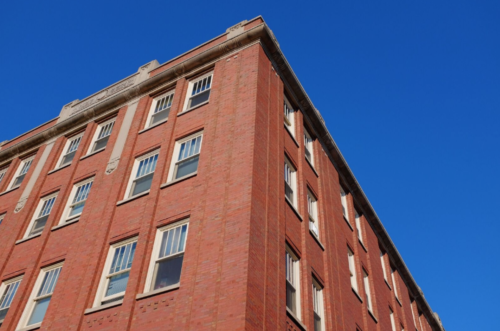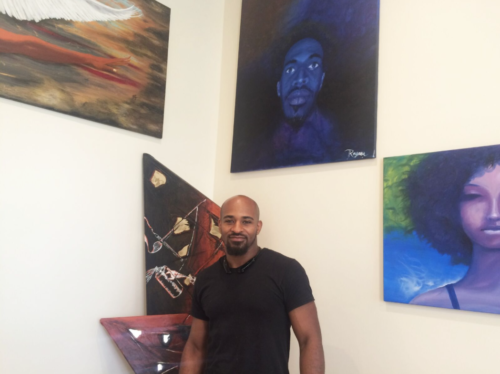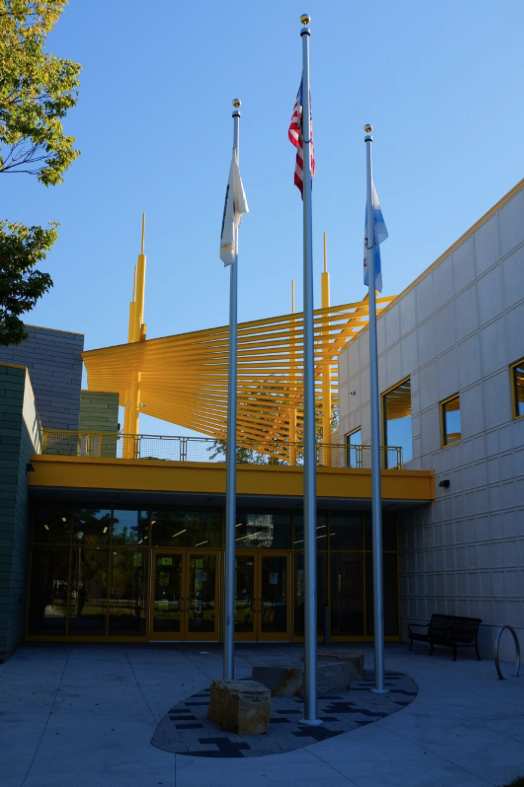- • Best Very Old Arts Recreation Hub
- • Best Very New Arts Recreation Hub
- • Best Arts Hub Designed By an MMA Fighter
- • Best Place to Exercise Your Free Will
- • Best Benevolence
- • Best Headgear
Bronzeville is a social construction,” writes Natalie Moore in her book The South Side, published earlier this year. She’s referring to the fact that, perhaps more than any other neighborhood on Chicago’s South Side, Bronzeville exists as the physical space of black identity and arts that flourished in the century that followed the beginning of the Great Migration. Bronzeville is defined by one of the grandest boulevards in Chicago, King Drive, lined on either side by of sweeping trees, red brick townhomes, and elegant greystones, complete with the original terra cotta ornamentation. Along the largest intersection, at 47th Street, neighbors hold friendly conversations while watering gardens, and a group of ladies sway their strollers back and forth across the sidewalk, catching up with old friends. This is a place where people greet you as they pass; here, the spirit of community, wrapped in pride of the neighborhood’s vibrant history, is very much alive.
As a result of the Great Migration, Bronzeville grew drastically between 1890 and 1950 as a community where African American residents explored new frontiers in music, art, literature, business, and political life. Industrial jobs, activist groups, and artistic cohorts began to develop as Bronzeville flourished into a site of collaboration and innovation, boasting economic growth and a distinct culture. Over the years, people like Ida B. Wells, Richard Wright, Nat King Cole, Louis Armstrong, and Gwendolyn Brooks called Bronzeville home and contributed to the neighborhood’s fast-moving arts revival.
This rich history also means that, perhaps more than any other South Side neighborhood, the revitalization of Bronzeville, which has been promised since the beginning of the 2000s but stubbornly fails to emerge (most recently due to the 2008 housing market crash), represents a dream deferred. Just last year saw the closure of Jokes and Notes, the city’s only black-owned comedy club, and H-Dogs, a gourmet hot dog joint owned by Cliff Rome, chef and board member of Bronzeville Area Residents and Commerce Council.
And yet, institutions like the Chicago Defender offices, the South Side Community Arts Center, Blanc Gallery (another of Rome’s endeavors), and Illinois Service Federal, a long-time black-owned insurance company, continue the legacy of Bronzeville’s past. The historic Wabash YMCA building, too, still fulfills its original purpose, providing a place for arts and education organizations to gather and go about their work. (Andrea Giugni and Kylie Zane)
Best Very Old Arts Recreation Hub
Historic Wabash YMCA

A long-standing pinnacle of the South Side’s black community, the YMCA standing on 38th and Wabash has been a neighborhood cornerstone for years. Founded in 1914 with the financial support of Julius Rosenwald, a businessman and philanthropist who was also the president of Sears at the time, the building was created to foster educational and professional opportunities for African Americans who had migrated from the South during the Great Migration. Today, it remains at the heart of the original “Black Metropolis,” providing a place for athletic groups, summer camps, art programs, and community services such as clubs for youth safety and violence prevention and youth leadership to thrive. The building’s long tradition of providing a hub for education and artistic development was recently embodied in the Chicago Poetry Block Party, a celebration of art, music, and poetry of all kinds, hosted in collaboration with Crescendo Literary (the joint project of Chicago-based scholar-poets Eve Ewing and Nate Marshall) and the Poetry Foundation. The event featured prominent Chicago artists such as Jose Olivarez and Ric Wilson, as well as Ewing and Marshall. The massive YMCA building was listed on the National Register of Historic Places in 1986 and given a $9 million renovation and reopening in the late 1990s by a coalition of neighborhood churches known as the Renaissance Collaborative (see below). (Andrea Giugni)
Wabash Avenue YMCA, 3763 S. Wabash Ave. Mon–Fri, 7am–9pm, Sat 9am–3pm. (773) 285-0020. ymcachicago.org.
Best Very New Arts Recreation Hub
Bronzeville Arts & Recreation Hub
The Bronzeville Arts and Recreation Center, a 32,000-square-foot, $18.3-million-dollar collaboration between the Chicago Parks District, Chicago Public Schools, the 3rd and 4th Wards, and two independent developers, and the result of more than a decade of planning, has finally opened in Ellis Park on 35th Street and Cottage Grove. Furthering city initiatives to expand services and opportunities on the South Side (before it opened, there were no public swimming pools between downtown and Hyde Park), the center hopes to reinforce Bronzeville’s critical sense of community. Rahm called it part of a “renaissance,” and the inaugural director of the center, Monique Scott, has called it an “urban oasis,” but even if you find those phrasings a little much, there’s no arguing it’s a meaningful addition to the neighborhood. With stellar arts programming, an Olympic-sized swimming pool, a brand-new gymnasium, and fully stocked classrooms (rare among Chicago Parks District facilities), the center represents a renewed effort to celebrate the storied history of Bronzeville and expand material possibilities for young people to sustain the neighborhood their ancestors shaped. (Andrea Giugni)
Bronzeville Arts and Recreation Center, Ellis Park, 3520 S. Cottage Grove Ave. Mon–Fri, 8am–8pm, Sat, 8:30am–5pm. (773) 285-7099. chicagoparkdistrict.com
Best Arts Hub Designed By an MMA Fighter
New Art Gallery and Jazz Lounge

Artist, educator, and, of all things, professional mixed martial arts fighter Deon Steward has designed, built, and inaugurated a new addition to the well-loved Senegalese restaurant Yassa, a Bronzeville staple featured in previous issues of Best of the South Side. Over the summer, Steward, who told DNAinfo the project aims to give neighborhood teens “freedom to be able to explore their talents,” renovated the adjoining two-story space and created a multipurpose art studio, classroom area, and gallery showcase (currently populated by his own oil paintings and sculptures). He hopes that establishing these programs in such a pivotal location will further a continually evolving reemergence of youth-focused art in Bronzeville—Yassa owner Madieye Gueye agrees, saying Steward’s work is “making a big difference” for the neighborhood. The space is open to young creatives seeking support for their art and Bronzeville locals who are looking to gain new skills, and is also rentable for private events. Plus, jazz. (Andrea Giugni)
New Art Gallery and Jazz Lounge, 3513 S. King Drive.
Best Place To Exercise Your Free Will
Simple Soups, Salads & Sandwiches
Sometimes you want a little bit of control, but without all the risks that come with making your own decisions. If you find yourself in a mood like this, look no further than Simply Soups, Salads, and Sandwiches on 47th, where you can customize your salads and sandwiches by choosing among dozens of vegetable, topping, bread, meat, and condiment options. This is amazing, yes, but what’s even more amazing is that every single item, from the bean sprouts to the boiled eggs to the buffalo chicken to the raspberry vinaigrette, is good. Or at least, I’ve never had a bad one so far. That’s it, that’s the whole story. Just go. (Jake Bittle)
Simply Soups, Salads, & Sandwiches, 635 E. 47th St. Mon–Fri, 7am–6pm. Sat, 9am–4pm. (773) 373-3810. simplyssands47th.com
Best Benevolence
The Renaissance Collaborative
The Renaissance Collaborative, a nonprofit organization that was originally founded in 1992 by four historical churches in the Bronzeville area (Quinn Chapel AME, St. Thomas Episcopal, St. Elizabeth Roman Catholic, and Apostolic Faith), came together to save the Wabash YMCA building (see above) from demolition. Today the nonprofit serves the South Side and Bronzeville in particular in myriad ways, primarily connecting low-income members of the Bronzeville community with affordable housing options and professional job opportunities (they believe homelessness can only be ended “one person at a time”). The Collaborative manages about 170 units of affordable housing in the Bronzeville area and offers literacy programs as well as regular fundraising initiatives to benefit arts and athletics in the neighborhood, which frequently involves partnerships with other organizations in the Wabash YMCA building. (Andrea Giugni)
The Renaissance Collaborative, 3757 S. Wabash Ave. (773) 924-9270. trcwabash.org
Best Headgear
Bronze Hat Line
Here’s my 1st set of hats for my line Bronze short for Bronzeville better known as Da LowEnd & the hood that made me pic.twitter.com/8KA1Uvyaz5
— dude ass (@lowkeydimo) June 13, 2016
Dimress Dunnigan isn’t afraid to rock blue hair and pink Nikes, and she doesn’t want you to be either: this summer, the Bronzeville designer launched a new hat line, “Bronze,” to let the rest of the world in on her personal style. These hats pay homage to Bronzeville, which Dunnigan calls “the hood that made me,” with small wooden plates on the front that read, simply, “bronze,” and beneath that, in smaller letters, “Chicago.” It’s a minimal statement, but a meaningful one. The line consists of corduroy baseball caps in rich, singular colors—navy blue, dark red, and yellow. They’re classic and comfortable, but also fresh and bold at the same time. Although Dunnigan’s first run sold out within just a couple days of their debut, those still hatless might not be much longer—Dunnigan tweeted last month that she has “some new shit coming soon.” (Lily Li)
Bronze Hat Line. For more information (and style inspiration), @lowkeydimo on Twitter and Instagram.
A previous version of “Best Headgear” stated that the places on the front of the Bronze hat line are made of metal. In fact, they are made of wood. Updated 9/21/2016

